"Ich bin ein Berliner...."

Welcome to Berlin. Behind me is the famous Brandenburg Gate. I came here to participate in the 52nd Annual Berlin Fulbright Seminar. It is a big conference of all the Fulbrighters here in Europe to get together, discuss weighty issues, and make contacts with other scholars, etc. However, it was also an opportunity to explore this legendary capital city.
 Berlin is an interesting place. I don't think I've ever seen so much construction going on in a single place. Even Boston's Big Dig is left in the dust by what is going on here. This square near our hotel (skyskraper on right) had 12 of these huge cranes in it plus half a dozen smaller ones. The blue water pipes suspended over the ground are typical of the disrupted utilities systems throughout this section of East Berlin.
Berlin is an interesting place. I don't think I've ever seen so much construction going on in a single place. Even Boston's Big Dig is left in the dust by what is going on here. This square near our hotel (skyskraper on right) had 12 of these huge cranes in it plus half a dozen smaller ones. The blue water pipes suspended over the ground are typical of the disrupted utilities systems throughout this section of East Berlin. Even the famous clock in Alexanderplatz (right below our hotel) was surrounded by piles of dirt, shattered bricks, and rumbling and beeping heavy machinery.
Even the famous clock in Alexanderplatz (right below our hotel) was surrounded by piles of dirt, shattered bricks, and rumbling and beeping heavy machinery. Everywhere in Berlin enormous creations of modern architecture are springing up, pushing the limits of conventional design and flooding an old city with monuments to the 21st Century.
Everywhere in Berlin enormous creations of modern architecture are springing up, pushing the limits of conventional design and flooding an old city with monuments to the 21st Century. The reasons why seem to be two-fold; 1.) Berlin is preparing for the World Cup Soccer Tournament coming in June (all games are already sold out), and 2.) the communist architecture of the former DDR is simply as depressing as a flat-lining heart monitor.
The reasons why seem to be two-fold; 1.) Berlin is preparing for the World Cup Soccer Tournament coming in June (all games are already sold out), and 2.) the communist architecture of the former DDR is simply as depressing as a flat-lining heart monitor. But we spent a good chunk of our week in East Berlin's finer establishments in hours of panel discussions and lectures such as this....
But we spent a good chunk of our week in East Berlin's finer establishments in hours of panel discussions and lectures such as this.... 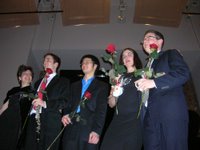 ...or the exquisite concert put on by the Europe Fulbrighters. (Cameron, our percussionist from Stockholm, is on the far right)
...or the exquisite concert put on by the Europe Fulbrighters. (Cameron, our percussionist from Stockholm, is on the far right)
 Between all these high-to-do, red-carpeted events we had an endless stream of excellent buffets with all the delicacies of German cuisine. I was particularly fond of the smoked herring...
Between all these high-to-do, red-carpeted events we had an endless stream of excellent buffets with all the delicacies of German cuisine. I was particularly fond of the smoked herring...All the lavish venues and VIP treatment made us feel very 'Fulbrighty' --if not outright spoiled. Most of us have been living in cramped hovels eating rice and beans to stretch our meager stipends and make ends meet--heck, I even lived on an old derelict ship!
At one of these banquets the waiters came by with their shiny silver trays loaded with these tasty delights-- 'Berliner's--made famous by John F. Kennedy's humorous pledge of support to the German People, "Ich bin ein Berliner."
Oops.
 The conference also provided us with a number of specialized tours. Being a museum studies masters student, I naturally took the tour to the Staatlische Museen zu Berlin on Museum Island (the island is in the river, so it hardly counts).
The conference also provided us with a number of specialized tours. Being a museum studies masters student, I naturally took the tour to the Staatlische Museen zu Berlin on Museum Island (the island is in the river, so it hardly counts).Our tour was led by the Director of Public Relations--who was still moaning about the trouble caused to him by the filming of another Nazi movie on the museums' front lawn the previous day. Hard to keep that objective, government appearance up when there are huge, red Nazi banners hanging off your buildings...
 The tour was fantastic. We saw the great treasures of the world 'gathered' by Germany in the early half of the century. Here, behind our guide here (the Indian Jones looking chap) you see the 3,000 yr old bust of Nefertiti in the Egyptian Collection.
The tour was fantastic. We saw the great treasures of the world 'gathered' by Germany in the early half of the century. Here, behind our guide here (the Indian Jones looking chap) you see the 3,000 yr old bust of Nefertiti in the Egyptian Collection. Next door in the Pergamon Museum stands the mighty Pergamon Temple, robbed from the acropolis over the Turkish City of Pergamum. I naturally hada grand time talking with our guide about his work , especially because the Staatlische Museen have the same unusual multi-institutional administrative structure the Vasa Museum has--but instead of the 3 museums the Statens Maritima Museer manages, the Staatlische Museen involves 17 museums!
Next door in the Pergamon Museum stands the mighty Pergamon Temple, robbed from the acropolis over the Turkish City of Pergamum. I naturally hada grand time talking with our guide about his work , especially because the Staatlische Museen have the same unusual multi-institutional administrative structure the Vasa Museum has--but instead of the 3 museums the Statens Maritima Museer manages, the Staatlische Museen involves 17 museums! Nearby the Pergamon Temple stands the amazing, blue glazed Ishtar Gate that once stood as the entrance to Babylon.
Nearby the Pergamon Temple stands the amazing, blue glazed Ishtar Gate that once stood as the entrance to Babylon.  We were also taken into several galleries finally undergoing renovation after being damaged in WW II and subsequently reverted to storage spaces and all but abandoned under the DDR.
We were also taken into several galleries finally undergoing renovation after being damaged in WW II and subsequently reverted to storage spaces and all but abandoned under the DDR. Then we headed out to see Berlin on our own. Our New Englander, Keith (left), was unable to restrain himself when he sighted a Dunkin' Donuts shop. Garrett, Kjersti, and I soon caved in to the temptation of a brief spate of gross Americanism too...
Then we headed out to see Berlin on our own. Our New Englander, Keith (left), was unable to restrain himself when he sighted a Dunkin' Donuts shop. Garrett, Kjersti, and I soon caved in to the temptation of a brief spate of gross Americanism too...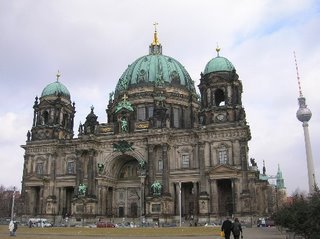 We toured the usual tourist traps; the big Cathedral known as the Berliner Dom....
We toured the usual tourist traps; the big Cathedral known as the Berliner Dom....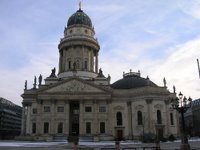 ...the Franzosichekirsche (French Church)...
...the Franzosichekirsche (French Church)... ...and got a good look at those forever-unique European cars. Aside from the expected plethora of Mercedes, Audis, and Volkswagens, we saw the classic Mini Coopers,....
...and got a good look at those forever-unique European cars. Aside from the expected plethora of Mercedes, Audis, and Volkswagens, we saw the classic Mini Coopers,.... ...some new miniature thing called a Smartcar that was so short it could park nose-in along the curb where only parallel parking was allowed...
...some new miniature thing called a Smartcar that was so short it could park nose-in along the curb where only parallel parking was allowed... ...and then a peppering of classic East German vehicles like this motorbike....
...and then a peppering of classic East German vehicles like this motorbike.... ...and the famous little Trabants.
...and the famous little Trabants.
We even ran into a dog team with a carriage on the streets of Berlin, already training for next winter.
 Eager to explore the traces of Berlin's wrenching 20th Century history, I then set out on my own. I decided to start from the Brandenburg Gate. It seemed a wise choice because when I arrived, an old gentleman with a portable crank-organ (cart on right) was playing "Lilli Marlene"--quite possibly my favorite song of all time (but only if sung by Lale Anderson)--the sentimental German tune sung by soldiers on both sides of the trenches in WW I.
Eager to explore the traces of Berlin's wrenching 20th Century history, I then set out on my own. I decided to start from the Brandenburg Gate. It seemed a wise choice because when I arrived, an old gentleman with a portable crank-organ (cart on right) was playing "Lilli Marlene"--quite possibly my favorite song of all time (but only if sung by Lale Anderson)--the sentimental German tune sung by soldiers on both sides of the trenches in WW I.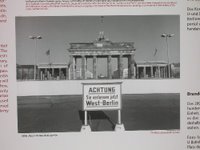 The Brandenburg Gate was also a good spot to start my tour of Berlin's 20th Century history because it stood as one of the most famous sections of the Berlin Wall....
The Brandenburg Gate was also a good spot to start my tour of Berlin's 20th Century history because it stood as one of the most famous sections of the Berlin Wall....  ..and was the site of the biggest protests, demonstrations, --and later-- parties when the wall finally came down in 1989.
..and was the site of the biggest protests, demonstrations, --and later-- parties when the wall finally came down in 1989. The Berlin Wall had destroyed Berlin as a unified city, splitting its population and even its architecture. Many buildings--some of historic significance--were demolished to clear a wide swath through the city for the wall and its broad security zone.
The Berlin Wall had destroyed Berlin as a unified city, splitting its population and even its architecture. Many buildings--some of historic significance--were demolished to clear a wide swath through the city for the wall and its broad security zone.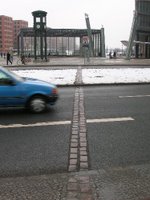 Today the wall is gone and only a cobble-stone scar tracking across the streets, over the sidewalks, and under new buildings attests to its former presence.
Today the wall is gone and only a cobble-stone scar tracking across the streets, over the sidewalks, and under new buildings attests to its former presence. However, by following this cobble-stone trail as I did, one eventually reaches a few remnants of the wall put out on display as a reminder of the trauma that lies at the root of Berlin's current problems of disparity and unemployment--and as tourist traps.
However, by following this cobble-stone trail as I did, one eventually reaches a few remnants of the wall put out on display as a reminder of the trauma that lies at the root of Berlin's current problems of disparity and unemployment--and as tourist traps.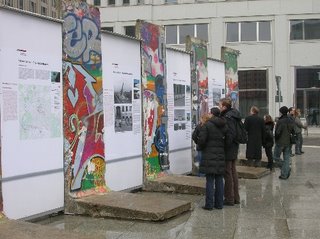 One outdoor exhibit along the street particularly caught my attention. The alternating panels of historical background and graffittied wall segments assemble a powerful message of anger, frustration, and social devastation. But then...
One outdoor exhibit along the street particularly caught my attention. The alternating panels of historical background and graffittied wall segments assemble a powerful message of anger, frustration, and social devastation. But then... ...going around the wall segment to the Western side where life was comparatively good--where being on this side of the wall meant not living in communist Europe--the graffitti was far less poignant or expressive. To the West, the falling of the wall largely meant a flood of unemployed workers and the huge economic burden of a collapsed nation.
...going around the wall segment to the Western side where life was comparatively good--where being on this side of the wall meant not living in communist Europe--the graffitti was far less poignant or expressive. To the West, the falling of the wall largely meant a flood of unemployed workers and the huge economic burden of a collapsed nation. 
Further along the cobble-stone scar one finds more sections of the wall still standing. This portion, protected by a wire fence, shows the chipped remains left by the throngs of East Germans that vented 40 years of imprisonment against the wall with sledgehammers and even rocks. The steel rebar, bent and battered, hangs out of the pitted and broken concrete like the raw nerves of the poeple it contained.
 Other sections of the wall on display behind protective fences show off some of the more impressive murals painted by Germans. This one--painted shortly after the wall came down--shows an East German Trabant crashing through the wall into the West.
Other sections of the wall on display behind protective fences show off some of the more impressive murals painted by Germans. This one--painted shortly after the wall came down--shows an East German Trabant crashing through the wall into the West.
Another panel--oddly not ooposite the previous--shows the front of the Trabant coming through. Note the license plate date.
 Another mural raises one of the post-reunification issues; demolition of the wall and the implications that has on the collective memory of what happened in Berlin. It reads, "Don't Destroy History." The debate is similiar to another European tragedy, the Holocaust, over which debates over the preservation of concentration camps continues unabated.
Another mural raises one of the post-reunification issues; demolition of the wall and the implications that has on the collective memory of what happened in Berlin. It reads, "Don't Destroy History." The debate is similiar to another European tragedy, the Holocaust, over which debates over the preservation of concentration camps continues unabated. 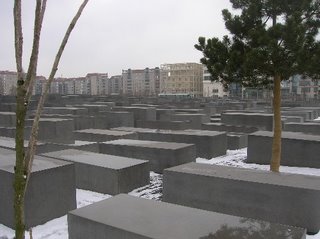
Berlin has recently approached the Holocaust issue quite directly. Last year, Berlin unveiled the new Holocaust Memorial which stands at the heart of the city, just south of the Brandenburg Gate. It is a haunting place with its 2,700 concrete stelae interspersed with a few scrawny trees and bushes....
 Every staele stands at a different height or a slightly different angle, instilling a sense of individuality in each piece--in each of the 6 million memorialized. Yet, sadly few who visit here seem to respect its significance and the otherwise solemn corridors are interrupted by middle-schoolers dashing about playing war games and throwing snowballs between the stelae.
Every staele stands at a different height or a slightly different angle, instilling a sense of individuality in each piece--in each of the 6 million memorialized. Yet, sadly few who visit here seem to respect its significance and the otherwise solemn corridors are interrupted by middle-schoolers dashing about playing war games and throwing snowballs between the stelae.
Yet the memorial's size allows you to wander far from its perimeter and the loud, rowdy crowds to where relative silence and tranquil reflection can be found, where the melting snow can be heard dripping rythimically onto the undulating brick pathways.
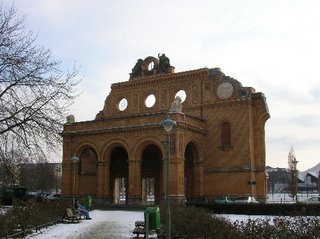
Berlin still shows other scars from that war. After searching London and Rome for war damage in the past, I was surprised by how much is still visible in this city. In one respect, that is to be anticipated. Berlin was nearly levelled by the Allied forces during the closing days of the war. Here, one of Berlin's grand cathedrals is reduced to this forlorn facade standing over a vacant park.
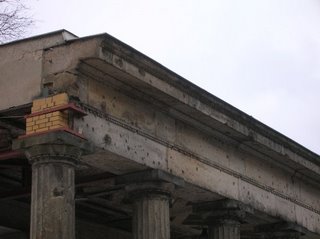 Elsewhere one can find buildings still riddled with bullettholes. This is the collonade around the Staatlische Museen zu Berlin on Museum Island, left unrepaired by the DDR.
Elsewhere one can find buildings still riddled with bullettholes. This is the collonade around the Staatlische Museen zu Berlin on Museum Island, left unrepaired by the DDR.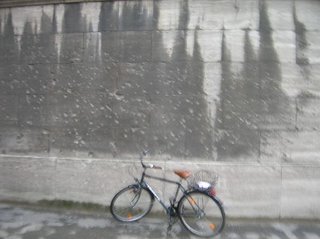
Another wall of the neglected museum showing the heavy barrage of rifle and machinegun fire that pocked its surface in 1945. Most of this damage is cocnentrated around doors, windows, and corners, points where the defending German Army--what was left of it--took cover in their fight against the invading Russian troops.
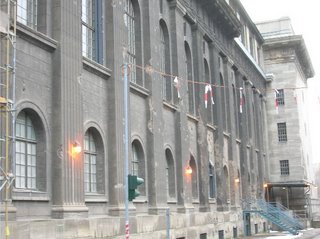 Another museum wall heavily damaged over 60 years ago and still awaiting repair.
Another museum wall heavily damaged over 60 years ago and still awaiting repair. Despite it all, there are still a few streets in Berlin displaying the prewar architecture, lucky neighborhoods that dodged the bombing and shelling.
Despite it all, there are still a few streets in Berlin displaying the prewar architecture, lucky neighborhoods that dodged the bombing and shelling.  But the scars of 20th Century German history are everywhere. Summarily, this site had both a section of the Berlin Wall (behind trees) and the remains of the Gestapo Headquarters, now an archeological excavation augmented by historical exhibits on Gestapo atrocities and Hitler's rise to power. It certainly cannot be said that Germans are not in tune with the embarassing and shameful parts of their history.
But the scars of 20th Century German history are everywhere. Summarily, this site had both a section of the Berlin Wall (behind trees) and the remains of the Gestapo Headquarters, now an archeological excavation augmented by historical exhibits on Gestapo atrocities and Hitler's rise to power. It certainly cannot be said that Germans are not in tune with the embarassing and shameful parts of their history. As fascinating as this historical tour of Berlin was, I began to feel that familiar itch to find the sea. As Berlin lies over 100 miles from the nearest coastline, my chances of finding any kind of shipping were severly limited and I feared that this statue of Neptune, the Roman God of the Sea, was the best I could do...
As fascinating as this historical tour of Berlin was, I began to feel that familiar itch to find the sea. As Berlin lies over 100 miles from the nearest coastline, my chances of finding any kind of shipping were severly limited and I feared that this statue of Neptune, the Roman God of the Sea, was the best I could do... II did, howevcr, have the benefit of sharing a hotel room with Michael (left), a Fulbrighter in Göteborg on Sweden's West Coast. He had lived aboard his 30ft sailboat in Southern California for a few years and that gave us hours of 'boat talk', but I still needed to find a real boat.
II did, howevcr, have the benefit of sharing a hotel room with Michael (left), a Fulbrighter in Göteborg on Sweden's West Coast. He had lived aboard his 30ft sailboat in Southern California for a few years and that gave us hours of 'boat talk', but I still needed to find a real boat. I found them on the River Spree in a small basin that--as far as I could tell-- was the entirety of Berlin Harbor. It berthed a few canal barges loaded with construction supplies (the local pass-time in Berlin)...
I found them on the River Spree in a small basin that--as far as I could tell-- was the entirety of Berlin Harbor. It berthed a few canal barges loaded with construction supplies (the local pass-time in Berlin)...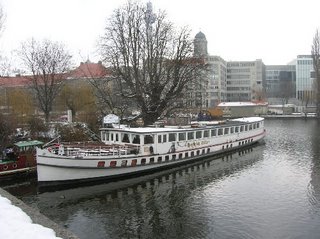 ...a tourboat-passenger steamer...
...a tourboat-passenger steamer...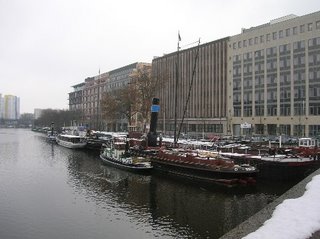 ...as well as a few tugs with hinged smokestacks so they could get under the bridges. None of them were very seaworthy looking, but it was satisying to see a hull nonetheless.
...as well as a few tugs with hinged smokestacks so they could get under the bridges. None of them were very seaworthy looking, but it was satisying to see a hull nonetheless.  Because these craft operate in the river it is necessary for them to have a number of very large grappling-hook style anchors that can hold fast against the current.
Because these craft operate in the river it is necessary for them to have a number of very large grappling-hook style anchors that can hold fast against the current. 
I even found the locks on the river just in time to see the diesel delivery barge come through, putting along under a haze of blue smoke as it made its run down river.
 Again, it wasn't particularly 'salty', but it was a boat anyway.
Again, it wasn't particularly 'salty', but it was a boat anyway.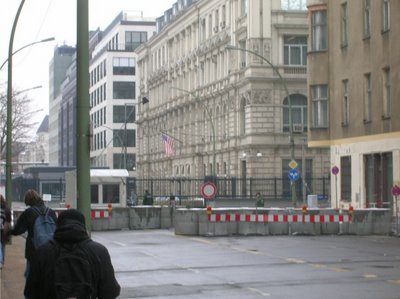 Well, that was Berlin as I saw it--mostly East Berlin (despite 16 years since reunification, they are still rather different cities). I'll leave you with this photo to ponder. Of all the foreign embassies I saw in Berlin, the US Embassy was the only one heavily barracaded and guarded by armed troops. Even the Chinese Embassy and the Turkish Embassy (often under attack) was far more relaxed. Interesting....
Well, that was Berlin as I saw it--mostly East Berlin (despite 16 years since reunification, they are still rather different cities). I'll leave you with this photo to ponder. Of all the foreign embassies I saw in Berlin, the US Embassy was the only one heavily barracaded and guarded by armed troops. Even the Chinese Embassy and the Turkish Embassy (often under attack) was far more relaxed. Interesting....
...I'l lleave you to contemplate the paranoia...
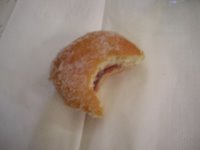

0 Comments:
Post a Comment
<< Home